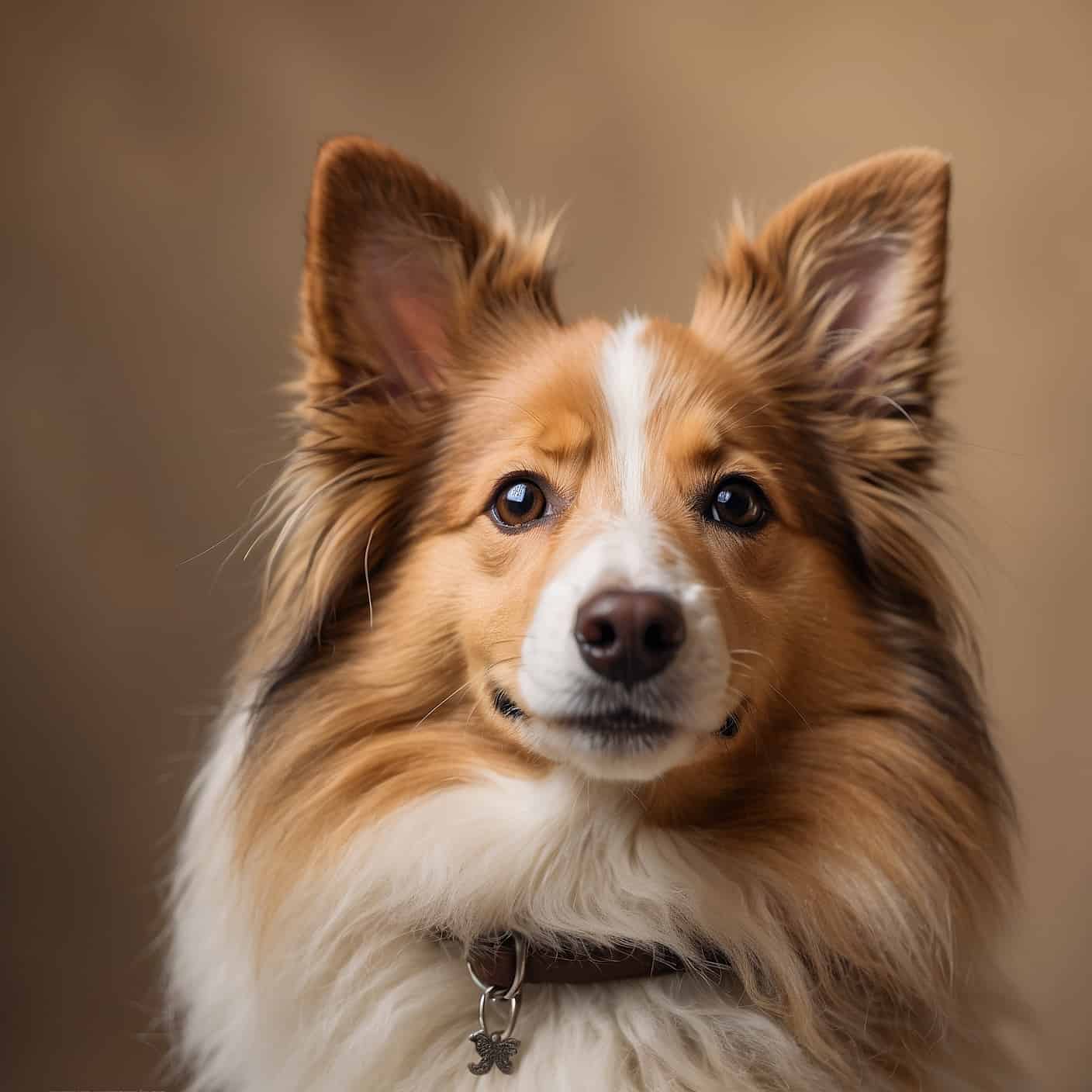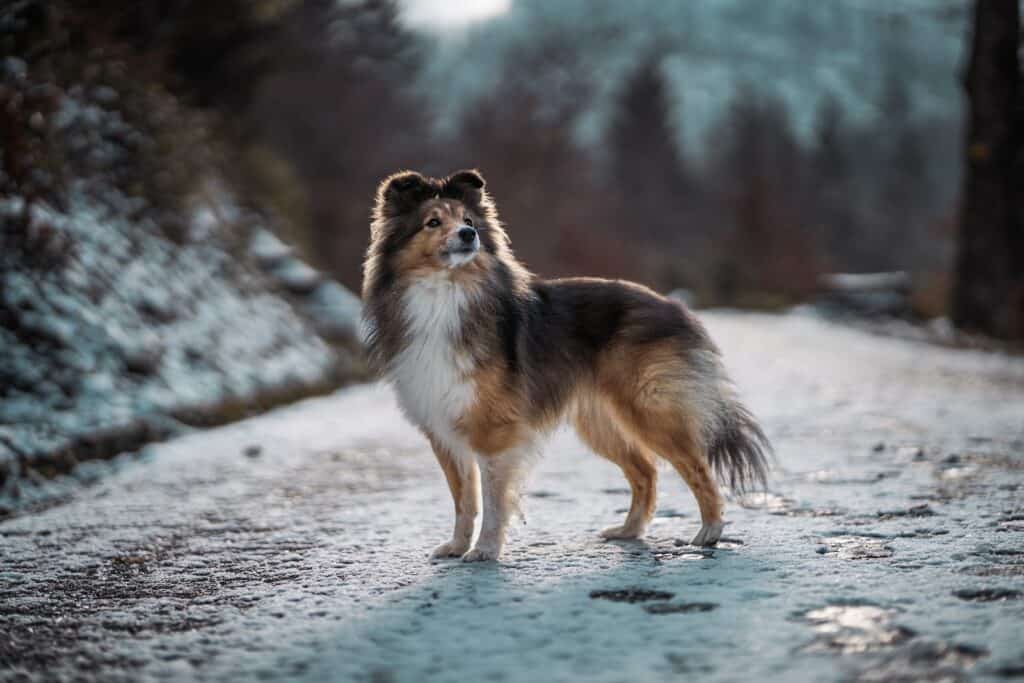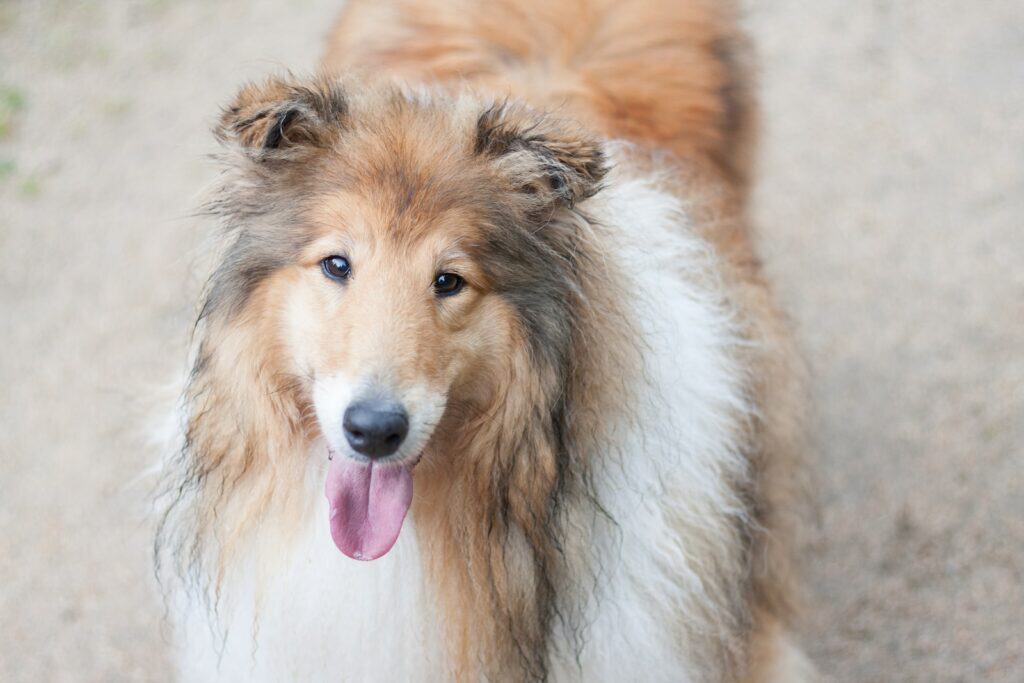The Shetland Sheepdog, a picture of intelligence, unwavering loyalty, and boundless energy, has captured the hearts of dog enthusiasts and families alike. With its roots in the Shetland Islands, distinctive physical features, and a unique set of personality traits, this breed has earned its reputation as a delightful and agile companion with herding instincts.

| Category (Explanation) | Breed Information |
|---|---|
| Year of Breed Conception | 19th century |
| Country of Origin | Shetland Islands, Scotland |
| Weight (lbs & kg) (Male) | 14-23 lbs (6-10.5 kg) |
| Weight (lbs & kg) (Female) | 12-20 lbs (5.5-9 kg) |
| Coat Type | Double coat with a mane |
| Color Variations | Various colors, often sable and white |
| Shedding Level (Low, Moderate, High) | Moderate |
| Height (cm & in) | 13-16 inches (33-41 cm) |
| Breed Size | Small to medium |
| Trainability (Low, Moderate, High) | High |
| Mental Needs (Low, Moderate, High) | High |
| Intelligence Level (Low, Moderate, High) | High |
| Energy Level (Low, Moderate, High) | Moderate |
| Agility (Low, Moderate, High) | High |
| Loyalty (Low, Moderate, High) | High |
| Playfulness (Low, Moderate, High) | Moderate |
| Exercise Needs | Regular exercise and mental stimulation |
| Guarding Proficiency (Low, Moderate, High) | Low |
| Sociability with Children (Low, Moderate, High) | High |
| Barking Level (Low, Moderate, High) | Moderate |
| Digging Tendency (Low, Moderate, High) | Low |
| Destructive Behavior (Low, Moderate, High) | Low |
| Drooling Level (Low, Moderate, High) | Low |
| Obedience Level (Low, Moderate, High) | High |
| Apartment Friendly (Yes/No) | Can adapt to apartment living with sufficient exercise |
| Inherent Prey Drive | Low to moderate |
| Physical Risk to Others (Low, Moderate, High) | Low |
| Travel Fatality Risk (Low, Moderate, High) | Low |
| Allergen Potential | Low |
| Health Concerns (List of Common Health Concerns) | Hip Dysplasia, Eye Issues, Collie Eye Anomaly |
| Average Life Expectancy (Life Expectancy in Years) | 12-14 years |
Woof Mastery is reader supported and our articles may contain affiliate links.
Instead of running third party ads that we have no control of we only use links from high-quality companies we are directly partnered with. Making use of these links come at no cost to you our reader, and in many cases have the extra benefit of discounted rates or sign up bonuses.
If you’re interested you can read more about our affiliate policy here.
We appreciate your support and always insure that the products and services we recommend are high-quality, helpful and relevant to the subject at hand!
The Shetland Sheepdog, often referred to as the Sheltie, hails from the Shetland Islands of Scotland. These dogs were originally bred for herding and working alongside farmers in the harsh climate of the Shetlands.
Shelties share ancestry with Collies and other herding breeds, resulting in their herding instincts and intelligence. Despite their smaller size, they proved adept at herding and guarding livestock.
Today, Shetland Sheepdogs are beloved for their agility, intelligence, and affectionate nature. They make wonderful companions and excel in various dog sports and obedience training.

What makes the Shetland Sheepdog special is its endearing charm and agility. These dogs are known for their elegance and grace in herding and dog sports. Their gentle and affectionate nature makes them cherished family pets.
Shetland Sheepdogs played a crucial role in herding and protecting livestock in the Shetland Islands and other regions. Their small size and intelligence made them adept herders, ensuring the safety of sheep and other animals. Today, they continue to exhibit their herding instincts in various dog sports and are cherished family companions, preserving their heritage as reliable working dogs.
Shetland Sheepdogs are known for their endearing and affectionate personalities. They are intelligent, agile, and have a strong desire to please their owners. These dogs are often described as gentle and loving companions.
Their intelligence and trainability make them quick learners, and they form strong bonds with their human families. Shetland Sheepdogs are characterized by their elegance, grace, and a sweet nature, epitomizing the ideal blend of agility and affection.
Shetland Sheepdogs are affectionate, intelligent, and gentle. They are known for their herding instincts but are typically good with children and other pets. They can be reserved with strangers.
Early socialization is important for their well-rounded temperament. They enjoy mental stimulation and physical activity.
Shetland Sheepdogs are small to medium-sized dogs with a well-proportioned and agile build. They have a refined head with expressive almond-shaped eyes. Ears are small and triangular, standing erect.
They have a double coat with a dense, weather-resistant outer coat. Coat colors typically include sable, black and white, or blue merle with various shades and white markings. Their tail is often feathered and carried high.
Males typically stand between 13 to 16 inches (33-41 cm) at the shoulder and weigh between 20 to 30 pounds (9-14 kg), while females are slightly smaller and lighter.
Shetland Sheepdogs have an alert and graceful presence, reflecting their herding heritage.
Shetland Sheepdogs come in various coat colors, including:
Shetland Sheepdogs often have a sable coat pattern, which includes various shades of light gold to mahogany with black tips. Some may have black and white coat patterns.
Shetland Sheepdogs have a moderate shedding level. They shed consistently with increased shedding during seasonal transitions. Regular grooming and brushing can help manage shedding and keep their coat in good condition.
Shetland Sheepdogs have a double coat that requires regular grooming to keep it healthy and minimize shedding. Grooming habits for this breed include:
1. Brushing: Regular brushing, about once or twice a week, is essential to prevent matting and remove loose fur. A slicker brush or an undercoat rake is useful for reaching the dense undercoat.
2. Bathing: Shetland Sheepdogs do not require frequent baths, as their natural oils help maintain coat health. Bathing should only be done when necessary, using a dog-specific shampoo. Be sure to rinse thoroughly.
3. Ears: Check and clean their ears regularly to prevent wax buildup or infections.
4. Nails: Keep their nails trimmed to a comfortable length to prevent discomfort and maintain proper gait.
5. Teeth: Dental hygiene is important. Brush their teeth regularly to prevent dental issues and bad breath. Dental chews or toys can also help.
6. Tail and Paw Care: Pay attention to the tail and paw areas, where dirt and debris can accumulate. Keep them clean and inspect for any signs of irritation or injury.
Shetland Sheepdogs have a moderate to high activity level and enjoy both physical and mental stimulation. Key points about their activity level include:
1. Exercise Needs: Shetland Sheepdogs require regular exercise to stay fit and happy. Daily walks, playtime, and interactive activities are beneficial.
2. Energy Level: They have moderate to high energy levels, especially when young. Regular exercise helps maintain their well-being.
3. Herding Heritage: Historically, Shetland Sheepdogs were bred for herding livestock. They excel in activities like agility, obedience, and herding trials.
4. Mental Stimulation: In addition to physical activity, mental challenges through training and puzzle toys are important to keep them engaged.
5. Family Dogs: They are known to be excellent family pets and enjoy activities with their human companions, such as agility and obedience.
Belgian Laekenois dogs are highly intelligent and known for their problem-solving abilities. Here are some key points about their intelligence:
Belgian Laekenois’ exceptional intelligence and versatility make them excel in a variety of roles. Training, socialization, and mental stimulation are essential for their development and well-being.
Shetland Sheepdogs are intelligent and need mental stimulation. Engage them in obedience training, agility, and interactive games to keep their minds sharp.
Social Interaction: They are social dogs and need regular interaction with their human family. Loneliness can lead to anxiety or destructive behavior, so provide companionship and attention.
Exercise: Mental exercise is equally important. Offer them tasks that challenge their problem-solving skills.
Training and Obedience: Shetland Sheepdogs benefit from obedience training, which not only stimulates their minds but also strengthens their bond with their owners. Consistent, positive-reinforcement training is effective in shaping their behavior.
Enter The Woof Mastery

If you’re thinking about a Shetland Sheepdog, consider these factors:
1. Exercise Needs: Shelties are active and require regular exercise and mental stimulation.
2. Training: They are intelligent and benefit from obedience training and socialization.
3. Space: Shelties adapt well to smaller living spaces but need exercise and playtime.
4. Coat Care: Regular grooming is necessary to maintain their double coat and prevent matting.
5. Herding Instinct: Shelties may exhibit herding behaviors, which can include chasing or nipping at family members.
Shetland Sheepdogs, while not as large as some breeds, may pose a physical risk to others if not properly socialized, trained, or managed. The risk assessment factors include:
1. Protective Instinct: Shetland Sheepdogs may have a protective instinct, especially towards their family. Proper training is essential to manage this instinct.
2. Socialization: Early and thorough socialization is crucial to ensure Shetland Sheepdogs are comfortable around people and other animals. Poor socialization can lead to fear or aggression.
3. Training: Obedience training is essential to teach Shetland Sheepdogs appropriate behavior and ensure they respond to commands. Well-trained dogs are less likely to engage in aggressive behavior.
4. Owner Responsibility: Responsible ownership involves being aware of the dog’s behavior and taking necessary precautions in public settings.
5. Breed-Specific Legislation (BSL): Shetland Sheepdogs may not be commonly subject to BSL, but owners should be aware of local regulations.
6. Individual Variability: Each dog is unique, and behavior can vary. Responsible ownership, proper training, and socialization are key to minimizing the potential physical risk to others.
Shetland Sheepdogs are often great with children. They are affectionate, intelligent, and enjoy playtime. Their herding instincts may lead to them trying to round up kids, but this behavior is generally manageable. Proper socialization is crucial for their interactions with kids.
Shetland Sheepdogs can be good swimmers. Their medium-sized build and agility often allow them to enjoy swimming. Some may have a natural instinct for it, while others might be more cautious. As with any dog, individual comfort levels vary, so ensure proper supervision when introducing them to water.
Positive training practices will assist your Shetland Sheepdog puppy in becoming a well-behaved and devoted companion.
Shetland Sheepdogs are considered moderate in terms of noisiness. They may bark to alert their owners, especially when they detect unusual sounds or activities. However, they are not known to be excessively vocal.
Shetland Sheepdogs thrive in homes that provide:
Challenges:
Traveling with Shetland Sheepdogs involves these considerations:
Shetland Sheepdogs are generally healthy, but they may be prone to certain health concerns, including:
Proper nutrition is vital for Shetland Sheepdogs. Follow these nutritional habits:
Proper nutrition is essential for the health and well-being of Shetland Sheepdogs.
Breed-specific laws (BSL) may affect Shetland Sheepdogs in certain areas, and it’s important for owners to be aware of these regulations. BSL is typically enacted at the local or municipal level and can vary widely from one jurisdiction to another. Here are some types of restrictions that Shetland Sheepdogs may face under BSL:
The rationale for BSL is often based on concerns about public safety and perceived risks associated with specific breeds. While Shetland Sheepdogs are not inherently aggressive, they can be affected by BSL due to their physical resemblance to breeds that are sometimes included in these laws.
It’s important to note that BSL is a controversial topic, and many advocates argue that it unfairly targets breeds rather than addressing individual dog behavior. They emphasize that responsible ownership, training, and education should be emphasized instead of breed-specific restrictions.
To determine if there are breed-specific laws or restrictions regarding Shetland Sheepdogs in your area, you should check with your local animal control or government authorities. Be aware of and comply with any local regulations to ensure that you are in compliance with the law while owning a Shetland Sheepdog.
Woof Mastery is reader supported and our articles may contain affiliate links.
Instead of running third party ads that we have no control of we only use links from high-quality companies we are directly partnered with. Making use of these links come at no cost to you our reader, and in many cases have the extra benefit of discounted rates or sign up bonuses.
If you’re interested you can read more about our affiliate policy here.
We appreciate your support and always insure that the products and services we recommend are high-quality, helpful and relevant to the subject at hand!
Myth 1: Shetland Sheepdogs are Miniature Rough Collies
Truth: Shetland Sheepdogs are a distinct breed, not miniature Collies. They have their own history and characteristics.
Myth 2: They are Only Suitable for Small Spaces
Truth: While they adapt well to apartments, Shetland Sheepdogs still need exercise and mental stimulation. They thrive in various living environments.
Shetland Sheepdogs, often referred to as Shelties, have made a name for themselves in various activities, and some famous examples include:
These Shelties have showcased the breed’s elegance and grace, particularly in conformation and dog shows.
Shetland Sheepdogs are beloved by families and dog lovers. Their history as herding and companion dogs has made them cherished members of many households. Specific historical owners may not be widely documented.
Shetland Sheepdogs, like all breeds, face certain challenges and dangers. Some of the greatest dangers and concerns for the breed include:
By understanding these challenges and providing responsible ownership and care, many of these dangers can be mitigated to ensure the well-being of Shetland Sheepdogs.
The Shetland Sheepdog, often called the “Sheltie,” originated in the Shetland Islands of Scotland. It was developed by crossing small mainland collie-type dogs with Shetland’s local small herding breeds. These dogs were selectively bred for herding and working in the challenging environments of the Shetland Islands.
The Shetland Sheepdog, often called the “Sheltie,” is a breed celebrated for its intelligence, agility, and affectionate nature. Whether herding sheep or being a loving family pet, Shetland Sheepdogs have a special place in the hearts of many.
Being a Shetland Sheepdog owner entails providing mental and physical activities, grooming, and regular veterinary care. Responsible ownership involves nurturing their herding instincts and addressing potential health concerns.
With their charming appearance and quick wit, Shetland Sheepdogs continue to be cherished for their versatility and unwavering companionship.